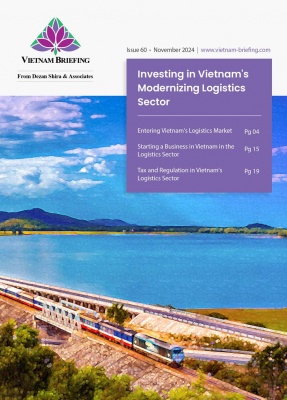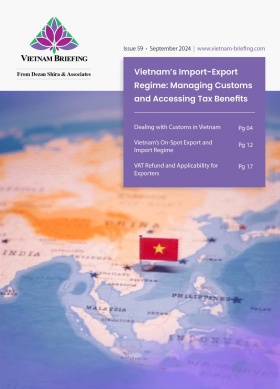Vietnam’s Medical Devices Market Outlook: Projections and Insights
Vietnam’s medical devices market is expanding rapidly, projected to reach US$1.77 billion by 2025. This offers enticing opportunities for both local and international players. In this article, we discuss key opportunities and challenges for businesses operating in this dynamic sector.
Continuous growth in Vietnam’s medical devices sector
As reported by Vietnam’s Ministry of Health (MOH), the nation’s medical equipment market was estimated to grow at a rate of 18-20 percent between 2016 and 2020. Notably, over 90 percent of medical equipment was sourced from abroad, primarily from Japan, Germany, the U.S., China, and Singapore. Products from these countries accounted for 55 percent of Vietnam’s total imports of medical equipment.
In August 2024, the Director-General of the Drug Administration of Vietnam (DAV) noted that the medical equipment market is thriving, reaching nearly US$1.7 billion. This has positioned Vietnam as the eighth-largest market in the Asia-Pacific region, with a compound annual growth rate (CAGR) of 10.2 percent. The rate reflected a decline from previous years’ 15-18 percent average.
|
Leading Companies in Vietnam’s Medical Devices Market |
||
|
Company |
Country |
Key products |
|
Bausch & Lomb India Private Limited |
U.S. |
Contact lenses, ophthalmic surgical devices, and eye care products (e.g., artificial tears)
|
|
Stryker Corporation Vietnam |
U.S. |
Surgical instruments, implants for joint replacement, neurotechnology devices, and emergency medical equipment |
|
USM Healthcare Medical Devices Factory JSC |
Vietnam |
Surgical gloves, catheters, medical disposables |
|
Medical Devices and Biomaterial Plant Joint Stock Company |
Vietnam |
Stents, orthopedic implants, and biomaterials for medical applications |
|
Getz Healthcare |
Australia |
Wound care products, patient monitoring devices, and surgical instrumentation |
|
Omron Healthcare Vietnam |
Japan |
Blood pressure monitors, nebulizers, and personal health devices (e.g., body composition monitors) |
|
B. Braun Vietnam Co., Ltd. |
Germany |
IV therapy products, surgical instruments, renal care products |
|
Hoya Lens Vietnam Ltd. |
Japan |
Optical lenses, prescription glasses, and medical optics |
|
Japan Vietnam Medical Instrument JSC |
Japan |
Diagnostic imaging equipment, surgical instruments, and patient monitoring devices |
|
Armephaco Joint Stock Company |
Vietnam |
Orthopedic devices, medical imaging equipment, and surgical and diagnostic instruments |
|
Terumo Vietnam Medical Equipment Co., Ltd |
Japan |
Infusion pumps, blood storage, transfusion equipment, atheters, and needles |
|
GE Healthcare Vietnam |
U.S. |
Imaging systems (CT, MRI), patient monitoring systems, and diagnostic ultrasound equipment |
|
Source: TechSci Research |
||
|
Vietnam’s Import of Medical Devices by Product, 2023 (*) |
|
|
Product |
Proportion (%) |
|
Articles of plastics and other materials |
37.7 |
|
Medicaments for therapeutic or prophylactic purposes |
28.5 |
|
Lenses, prisms, mirrors |
4.9 |
|
Medical instruments and appliances |
3.4 |
|
Medical needles, catheters, cannula |
2.7 |
|
Implants |
2.3 |
|
Others |
20.5 |
|
(*)Note: 100% = US$6,388.5 million |
|
|
Source: B&Company |
|
|
Vietnam’s Import of Medical Devices by Country of Origin, 2023 (*) |
|
|
Country |
Proportion (%) |
|
China |
32.1 |
|
South Korea |
10.3 |
|
Japan |
7.8 |
|
Germany |
6.5 |
|
U.S. |
5.8 |
|
Others |
37.5 |
|
Source: B&Company |
|
Vietnam’s medical devices market outlook
Vietnam’s medical devices market is expected to see substantial revenue growth in 2025—and reach US$1.77 billion in value—per data from Statista. Within the broader medical devices market, cardiology devices are projected to dominate as the largest category at US$292.99 million.
Looking forward, analysts see the medical devices market in Vietnam growing at an 8.62 percent CAGR from 2025 to 2029, culminating in a market volume of US$2.47 billion by the end of 2029. This sustained growth—driven by rising healthcare expenditure and efforts to strengthen the country’s healthcare infrastructure—presents significant expansion and investment opportunities in the medical devices sector.
Key growth drivers
Several factors make the medical devices sector in Vietnam increasingly attractive to global and homegrown investors alike.
Aging population
Vietnam currently has over 1,300 hospitals and medical facilities serving more than 100 million people. Simultaneously, its population is aging, with the share of elderly individuals rising from approximately 12 percent in 2019 to nearly 14 percent by 2023.
This increase aligns with the upward trends in chronic diseases and conditions associated with aging. The World Health Organization (WHO) reports that about 22 million Vietnamese live with chronic diseases. Vietnam ranks fifth in male and second in female life expectancy among Southeast Asian countries, with an average life expectancy of 73.7 years. Individuals spend around 10 years managing chronic health conditions, creating a growing demand for healthcare services and opportunities for expansion in the healthcare and wellness sectors.
It is also projected that by 2050, the elderly demographic will make up a quarter of the total population in Vietnam. This shift shows the urgent need for a better healthcare system, as older adults generally have the highest demand for and spending potential in healthcare services.
Improving living standards
Living standards in Vietnam are rising across both urban and rural areas. As consumers become more health-conscious, they are increasingly willing to invest in healthcare products and equipment.
Industry reports indicate that while total annual per capita expenditure declined by 3.3 percent nationwide from 2020 to 2022—falling 13.5 percent in urban areas—healthcare spending surged by nearly 25 percent, increasing from US$153 to US$189.
Growing healthcare awareness
Improved education and internet access are driving greater health awareness in Vietnam, influencing consumer attitudes and healthcare-seeking behaviors. As health literacy improves, more individuals recognize the importance of proactive health monitoring, early diagnosis, and preventive care to reduce chronic illness risks.
This shift has fueled demand for medical devices that support health monitoring, early detection, and preventive care.
Government policy measures
Vietnam has introduced strategic initiatives to attract foreign investment and promote technology transfer, strengthening the growth outlook for the medical devices sector:
- National Strategy for Developing Vietnam’s Pharmaceutical Industry (2030, Vision 2045): Approved in October 2023, this strategy aims to meet 80 percent of national pharmaceutical demand through domestic production, accounting for 70 percent of market value by 2030.
- Grassroots Healthcare Network Development Plan (2021-2030, Vision 2050): This plan prioritizes public investment to enhance healthcare infrastructure in economically disadvantaged areas, including remote, border, and island regions.
Navigating Vietnam’s medical devices market: Key considerations
Vietnam’s medical device market offers lucrative opportunities, but companies must navigate its unique challenges for successful entry. Key factors to consider include:
- Changing regulations: The government is reforming healthcare laws, necessitating that businesses remain compliant with evolving strategies.
- Strict certification requirements: Companies must register medical devices with the IMDA or local health departments, a process that can take 2 to 3 years.
- Import licensing: An import license or market authorization certificate is required for medical device imports, obtainable only by a legal entity in Vietnam. Japanese firms must establish a local presence or partner with a Vietnamese distributor.
- Required a lump-sum of investment: Establishing manufacturing requires significant capital, along with further investment in R&D and obtaining market authorization.
- Healthcare infrastructure constraints: Despite economic growth, healthcare resources are unevenly distributed, particularly in rural areas, posing challenges for advanced medical technology adoption.
- Limited domestic manufacturing: Vietnam relies heavily on imports due to nascent local manufacturing capabilities. To build a self-reliant medical device industry, efforts should focus on enhancing production capacity, promoting technology transfer, and investing in R&D to meet the country’s healthcare needs.
Takeaways
Vietnam’s demand for medical devices is growing significantly, driven by an aging population, heightened healthcare awareness, and improved living standards. These factors are enabling more citizens to access advanced medical services. With various government initiatives and strategic plans in place, the sector presents several greenfield and brownfield investment prospects for investors.
However, entering the Vietnamese market comes with its own set of risks and strategic considerations, requiring businesses to adopt a well-thought-out approach for success. Key actions to consider include:
- Conducting a comprehensive legal analysis: A thorough understanding of the Vietnam general and sector-specific legal landscape is essential for crafting a strategic plan for market penetration. Gaining insights into local practices, laws, and regulations will help businesses navigate potential hurdles effectively.
- Building a strong local network: Establishing robust relationships and partnerships with key local official and industry stakeholders is necessary to ensure your business stays compliant and is informed of sectoral trends and regional opportunities for growth.
- Training: Rigorous training sessions are vital for successfully implementing sales, marketing, promotional activities, and technical and clinical application services during later phases of market entry.
- Investing in long-term operational support: Business leaders should prioritize long-term investments that support ongoing operations. This includes elements such as consignment inventory management (CIM), expedited delivery, regulatory affairs, and compliance management, all of which are essential for meeting business objectives.
- Partnering with market expansion experts: Collaborating with a trusted partner who specializes in market expansion can provide significant advantages. Such a partnership can streamline market entry and facilitate sustainable growth.
About Us
Vietnam Briefing is published by Asia Briefing, a subsidiary of Dezan Shira & Associates. We produce material for foreign investors throughout Asia, including ASEAN, China, and India. For editorial matters, contact us here and for a complimentary subscription to our products, please click here. For assistance with investments into Vietnam, please contact us at vietnam@dezshira.com or visit us at www.dezshira.com.
Dezan Shira & Associates assists foreign investors throughout Asia from offices across the world, including in Hanoi, Ho Chi Minh City, and Da Nang. We also maintain offices or have alliance partners assisting foreign investors in China, Hong Kong SAR, Dubai (UAE), Indonesia, Singapore, Philippines, Malaysia, Thailand, Bangladesh, Italy, Germany, the United States, and Australia.
- Previous Article 越南工业园区:2025-2030年增长展望
- Next Article The Impact of Tariffs on Vietnamese Exports: US-Vietnam Trade Relations Under Trump 2.0































